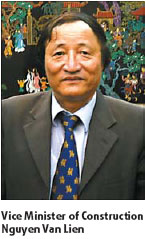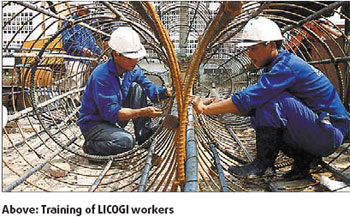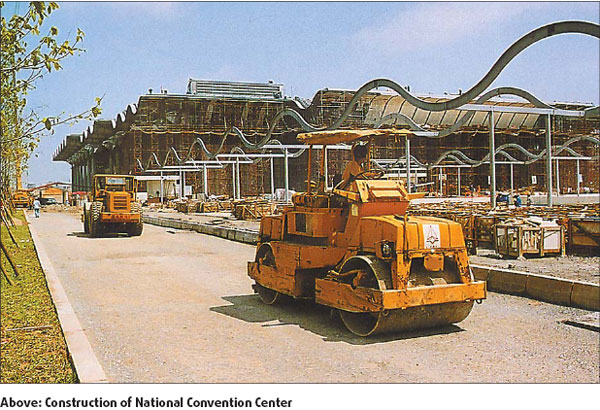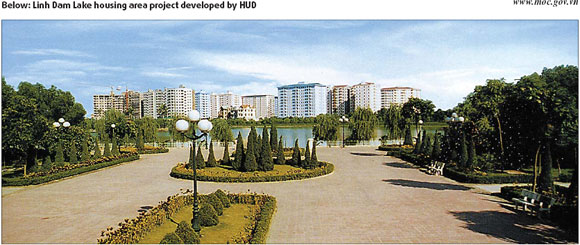Building the modern way

The construction sector in Vietnam - building, construction materials, architectural planning, and urban housing development - has made leaps and bounds, a measure of the industry's success.
Since the Communist Party of Vietnam and the State launched the Doi Moi economic reforms in 1986, permitting free-market enterprises, Vietnam has opened its doors to major development opportunities.
With international integration and development attracting partnerships and joint ventures, this cooperation has made it possible for the Vietnamese to master technologies and techniques for large-scale construction projects.

"Before the Doi Moi process, Vietnam relied on international labor; now we are able to master highly complex technological buildings," Vice Minister of Construction Nguyen Van Lien, said.
"If you see the high-rise buildings around Hanoi and Ho Chi Minh City, the majority are designed and constructed by Vietnamese.
"One example of our achievements is the Hoa Bin hydropower plants; at the time it was the largest in Southeast Asia with a capacity of 1,900 MHz and was constructed with the help of international engineers and experts. At present, we are constructing a larger 2,400 MHz power plant that will be built with our own labor force."
The National Convention Center in Hanoi - the site of the 2006 APEC leaders meetings - is the largest building of its kind in Southeast Asia. A local contractor completed the structure, with the assistance of German consultants.
"We are able to master major projects in Vietnam, except for perhaps extraordinarily large projects such as 60 or 80-storey buildings, for which we still have to consult international experts," Lien said.
In industrial development, construction enterprises are the major investors in cement, building materials, hydropower plants and thermal power plants.
The cement factory in Tan Long - a local investment - produces 2 million tons of cement per year. For high-capacity thermal power plants, Vietnamese businesses are striving to obtain better technologies to master the projects. Vietnamese enterprises can decide on their own whether they want to use international standards for their projects or Vietnamese standards. The only condition is that they must maintain the same quality.

The construction material industry has gained special importance for investment. Product quality has been enhanced, reducing the need for importing products, and simultaneously accelerating exports. Technologically advanced, large-scale production assembly lines have been constructed, especially for cement, artificial ceramics and granite tiles, sanitary wares and construction glass.
World Bank Vice President James Adams had glowing praise for Vietnam's ability to undertake major projects.
"Vietnam is a country that when it puts its mind to an infrastructure project, it is done very well," he said.
"Rural electricity and the grid system have rapidly expanded, with improved performance. The economy is growing so quickly that (the government) has had very little time to sit back and reflect on its achievements. I think the interesting challenge is what policies government officials pursue at this level of income and why they should be different from some of the policies they pursued in the past."
Taking the initiative
"The national objective of Vietnam by the year 2020 is the industrialization and modernization of our country," Lien said.
"We aim to become an industrialized nation with modern technical facilities, strong economic structure, and progressive trade relations in order to fully utilize our production force's development capacity. The goal is to bring about high material and spiritual lives, solid national defense and security, rich population, strong nation, the democratic, equal and civilized society. From now on to the year 2020, every effort will be made in order to change our country into an industrialized nation."
To achieve this ambitious objective, the construction sector will implement several programs.

By 2020 the urban development orientations will re-structure urban systems throughout the country. Because of population growth and swift urbanization, regional planning will focus on urban housing issues, especially near key economic regions. Urban areas will play a role as administrative, economic and cultural centers in each region and locality in Vietnam.
"The industrialization process is closely connected with urbanization and industrial development, which will lead to a redistribution of the population - a driving force for socio-economic development," Lien said.
According to the industrialization and modernization policy, increased decentralization will clearly identify the roles and responsibilities of entities that take part in construction. This change will ensure the rate of progress, enhance the quantity and quality of production, and create a legal framework that will be the driving force to foster investment activities in the construction sector.

The key task of all stages in the construction investment operation is to strengthen the effectiveness of state management. To become more competitive, the construction enterprises have begun privatization to stabilize their organizational structures, modernize technology, and create international partnerships.
Housing programs are being implemented to increase funds for selling and leasing. The goal is to meet the housing demand for beneficiaries of social welfare and the poor through preferential policies. By 2010, Vietnam's objective is for 100 percent of the population to have a house, with an average area of 12-14 sq m per person. Investment policies in housing construction leases must be implemented to partially deal with this urgent matter. Consistent monitoring is necessary to increase the supply of products on the real estate market in Vietnam.
In addition, the urban infrastructure system will be comprehensively built up and gradually modernized to improve the water supply system and to solve water drainage and waste treatment problems in urban areas.
Overcoming challenges
Vietnam and the construction sector face many challenges, according to Vice Minister Lien. "There is both domestic and international competition now in all aspects of the construction sector," he said.
"The second challenge we have is our poor infrastructure. Due to many years of war, we cannot recover in a short period of time. We need more financial aid; it will be very hard to build up the infrastructure as quick as we would like to without that aid. The next challenge is sustainable development. Economic goals have to go along with poverty reduction. There is a gap between living standards; a reduction of inequality between the social statuses of different classes in Vietnam must take place."
Vietnam also faces environmental protection issues, as some investors do quick projects without paying any attention to environmental concerns.
One final challenge the country faces is corruption.

"Our government has taken major steps in the fight against corruption with full support from the Vietnamese people who are very aware of the problem. This process will continue," Lien said.
International perspectives
The Vietnamese government aims to lift spending on infrastructure to 11 percent of gross domestic product (from about 9 percent now), which will spur construction activity. Key development areas include power, urban transport, water supply, sanitation, road construction, and ports.
Asian Development Bank Country Director Ayumi Konishi said: "The government certainly is trying to attract more foreign direct investment into infrastructure development.
"Through many different kinds of public-private partnership arrangements, we are helping the government to create an environment for further private sector participation in infrastructure development. For example, amid the planning of the mass transit system in Ho Chi Minh City, one of the key issues is how to bring in private sector investment."
Growing the power sector by about 15 percent per year is another key goal.
To accomplish that, Vietnam will invest $3-4 billion per year in power infrastructure between now and 2010.
International Finance Corporation Country Manager Sin Foong Wong said: "The ports are being developed to facilitate increased trade, and telecommunication networks have been increasing tremendously. Road networks and urban infrastructure are also key growth areas.
"In the power sector you have companies like AES which are building large power plants, and in ports you have companies like SSA from the United States and PSA from Singapore. Such investment goes beyond just the local consumer market. It is really helping build the country's infrastructure, and will hopefully reach as far as education and skills training, drawing interest from the United Kingdom, Australia, and Canada in providing such services."
Connecting the region

Major transportation projects include the East-West Economic Corridor linking Da Nang to Laos and Northern Thailand, the Ho Chi Minh City to Phnom Penh road link, the Hanoi to Lao Cai railway rehabilitation and expressway project, and the Southern Coastal Corridor construction.
"All road and railway projects are contributing to the connectivity of the sub-region, which is an important goal in sight," Konishi said.
"Furthermore, if people go through the feasibility studies of the roadways, there are many sections, which make good economic as well as financial sense. For the six Greater Mekong Sub-Region (GMS) countries, the new cross-border transportation agreement will allow the movement of goods and people through border points to effectively utilize the cross-national roads, allowing better access to urban areas. New townships and industrial areas are being developed and new economic activities are happening, which is really amazing. Particularly through better transportation, energy and communication links with regional countries, Vietnam's development can also benefit from the development of the region as a whole. Vietnam has good potential to support the development of other countries in the region."
Cooperation with China

Wong said: "China and Vietnam have a long history between them, and the government relationship grows stronger by the day. The 'Two Corridors, One Economic Belt' initiative to link the northern part of Vietnam to the southern part of China will allow for cross-border investment, especially in the power sector, but also in agriculture and steel. We are beginning to see increased interest from the Chinese companies coming into Vietnam, so I would not be surprised if Chinese investment would pick up in the future."
As part of the ASEAN-China cooperation framework, the Vietnam-China "Two Corridors, One Economic Belt" consists of the Kunming - Lao Cai - Hanoi - Hai Phong corridor, Nanning - Lang Son - Hanoi - Hai Phong corridor, and the Tonkin Gulf economic belt.
(Shanghai Start 09/03/2007 page2)














